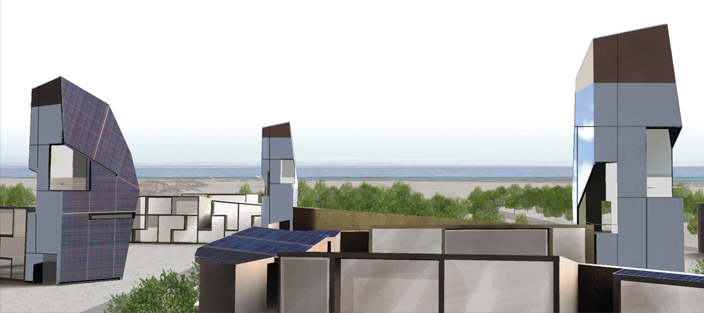The traditional model of growth is a zero sum game with discrete
land use typologies, where growth in one area can only happen
at the expense of another. Our primary motivation in developing
this model systemic community is to provide a paradigmatic
shift in accommodating growth: by harnessing and integrating
systems that are cyclical in nature and time, the community will
rejuvenate and heal the surrounding ecology with every cycle
rather than eroding it over time.
The approach is holistic, in that we consider interrelationships
between all processes fundamental to sustaining life and preserving
nature: water and energy cycles, agriculture and seasonality,
production and the exchange economy, as well as social needs of
a multi-generational community. Furthermore, our strategy
is hinged on the notion of restoring scarred landscapes,
making them givers of life, and enhancing their integration into the
surrounding ecology and life.
The process of healing is emphasized by a symbiotic relationship
between the community and the natural environment. The goal
is to create a community that has a 0 net impact on emission,
waste, energy and water while reducing the Sea salinity level and
maintaining the ecosystem it supports.
The project focuses on the illustration of the model community as
case study of not only sustainable architecture but as example of a
biomimetic approach to design inspired by natural eco-systems.
The project illustrates how our individual ecological footprint is
much larger then we are aware off. The project designs a community
not only composed of the housing and the public spaces around
it, but that incorporates all the other elements necessary to feed,
employ and create an exchange economy with the surrounding
communities. This interconnectivity does not produce waste, but
creates a chain of usage. This phenomenon although common in
nature is still a novelty in architecture and exploring its potentials
has been the team’s challenge.
In Working with constant feed back loops nature has learned how
to adapt and survive. This community similarly learns and evolves
based on the interaction between all entities. The farmlands, clean
factories, algae farms, solar ponds, area productive eco-system
that uses land, air, sun, and water as fundamental elements of
life without exploiting but allowing the natural cycles to function in
balance. With this process the scarred land of Salton Sea will have a
chance to produce a new healthy life for all its inhabitants: flora,
fauna and human kind and fi nally synchronize with nature’s rhythm of life.






